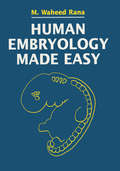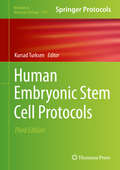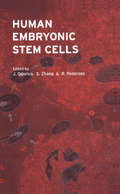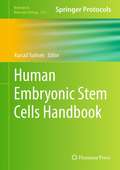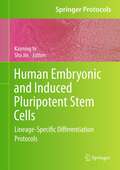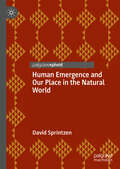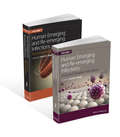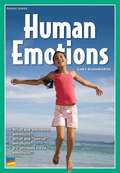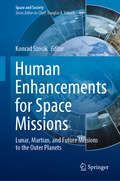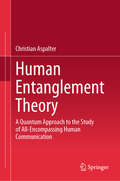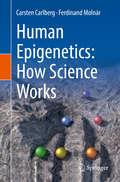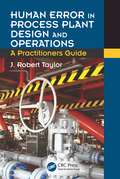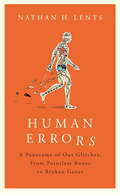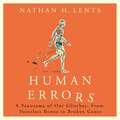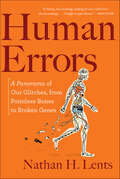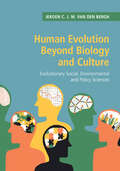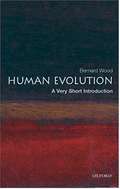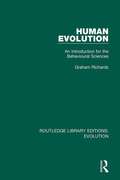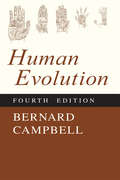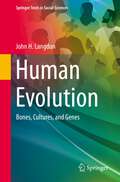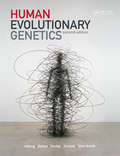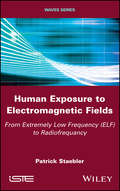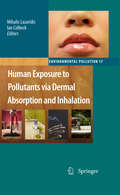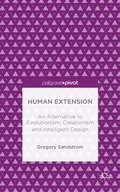- Table View
- List View
Human Embryology Made Easy
by Abdul Hamid RanaThis book is a synopsis of the key facts and concepts of human development. It is intended for students who are taking a human embryology course. The book includes the underlying mechanisms involved in clinically important congenital anomalies that will prove useful to medical and nursing.
Human Embryonic Stem Cell Protocols
by Kursad TurksenDespite political and ethical controversies surrounding the study of human embryonic stem (hES) cells, new freedoms in regard to using them for research has allowed interest to remain high in understanding the regulatory mechanisms of stem cell self-renewal, their differentiation along various lineages, and their potential use in regenerative medicine. In Human Embryonic Stem Cell Protocols, Second Edition, internationally respected researchers expand upon the popular first edition and describe in detail their most useful techniques for the molecular and cellular manipulation of these intriguing cells. This diverse collection of readily reproducible methods has been optimized for the derivation, characterization, and differentiation of hES cells, with special attention given to regenerative medicine applications. As a volume of the Methods in Molecular BiologyTM series, chapters include brief introductions to their respective topics, lists of the necessary materials and reagents, step-by-step laboratory protocols, and notes on troubleshooting and avoiding known pitfalls. Comprehensive and cutting-edge, Human Embryonic Stem Cell Protocols, Second Edition offers both novice and expert researchers powerful tools essential to understanding the maintenance and differentiation of human embryonic stem cells, as well as their applications in regenerative medicine today.
Human Embryonic Stem Cells
by J. Odorico S. C. Zhang R. PedersenSince the first successful isolation and cultivation of human embryonic stem cells at the University of Wisconsin, Madison in 1998, there has been high levels of both interest and controversy in this area of research. This book provides a concise overview of an exciting field, covering the characteristics of both human embryonic stem cells and pluripotent stem cells from other human cell lineages. The following chapters describe state-of-the-art differentiation and characterization of specific ectoderm, mesoderm and endoderm-derived lineages from human embryonic stem cells, emphasizing how these can be used to study human developmental mechanisms. A further chapter discusses genetic manipulation of human ES cells. The concluding section covers therapeutic applications of human ES cells, as well as addressing the ethical and legal issues that this research have raised.
Human Embryonic Stem Cells Handbook
by Kursad TurksenConsiderable advances have taken place since the initial isolation and characterization of human embryonic stem (HES) cells; however, significant challenges remain before their potential for restoration and regeneration processes in patients can be realized. Understanding the diversity amongst HES cell lines and realizing the ability to isolate lines with robust differentiation potential remain difficult. In the Human Embryonic Stem Cells Handbook, experts in the field provide an assortment of protocols that have been used by various laboratories around the world so as to allow both novices and experienced investigators to compare and contrast different approaches to HES cell isolation and characterization with the hope that, from these protocols, researchers might standardize approaches for HES cell biology. Written in the Methods in Molecular BiologyTM series format, chapters include introductions to their respective topics, lists of the necessary materials and reagents, step-by-step, readily reproducible laboratory protocols, and tips for troubleshooting and avoiding known pitfalls. Authoritative and accessible, Human Embryonic Stem Cells Handbook serves as a valuable reference for scientists pursuing this vital field and its enormous potential.
Human Embryonic and Induced Pluripotent Stem Cells
by Kaiming Ye Sha JinBecause of the huge potential of human embryonic stem (hES) cells, especially the newly developed human induced pluripotent stem (hiPS) cells, in disease treatment and life quality improvement, enormous efforts have been made to develop new methodologies to translate lab discoveries in stem cell research into bed-side clinical technologies. In Human Embryonic and Induced Pluripotent Stem Cells: Lineage-Specific Differentiation Protocols, experts in the field present a comprehensive collection of protocols designed for labs around the world. The topics covered in this detailed volume include techniques used for maintenance of hES and iPS cells in either small or large scale, techniques for directing hES and iPS cell lineage specification, techniques for enhancing the maturity of differentiated hES and iPS cells within three-dimensional scaffolds, techniques for reprogramming adult cells into iPS cells, techniques for generating patient-specific iPS cells, and techniques for translating hES and iPS cell research into new therapies. Chapters include lab ready protocols with tips on troubleshooting and avoiding known pitfalls. Wide-ranging and authoritative, Human Embryonic and Induced Pluripotent Stem Cells: Lineage-Specific Differentiation Protocols will be a tremendous aid for researchers and students who wish to explore these areas and transform their discoveries into the next generation of regenerative medicine and tissue engineering technologies.
Human Emergence and Our Place in the Natural World
by David SprintzenThis book challenges the prevailing, though often unacknowledged, view among most practicing scientists and philosophers that human free will is incompatible with the natural causality that is the basic presupposition of modern science. That position is essentially based on the reductionist view of modern physics that all complex phenomena are thought to be ultimately causally explainable solely as a function of the action of their elemental constituents. The book argues that this mainstream opinion is the appropriate logical result of an inadequate conception of the way nature works. To show this the book first details the fundamental philosophical incoherence in the prevailing scientific world view. It then justifies the critique by outlining and re-describing some key findings of modern science, and presents three related alternative aspects by which we can understand the occurrence of natural emergence. In so doing it is suggested that emergence is a pervasive phenomenon in the natural world, and that human free will is an entirely understandable development of these natural processes, when properly understood, in which humanity is appropriately seen as a natural emergent within the evolutionary processes operating in accord with natural selection. Human Emergence and Our Place in the Natural World is essential reading for all philosophers of metaphysics and of science.
Human Emerging and Re-emerging Infections Set
by Sunit K. SinghEmerging and re-emerging pathogens pose several challenges to diagnosis, treatment, and public health surveillance, primarily because pathogen identification is a difficult and time-consuming process due to the "novel" nature of the agent. Proper identification requires a wide array of techniques, but the significance of these diagnostics is anticipated to increase with advances in newer molecular and nanobiotechnological interventions and health information technology. Human Emerging and Re-emerging Infections covers the epidemiology, pathogenesis, diagnostics, clinical features, and public health risks posed by new viral and microbial infections. The book includes detailed coverage on the molecular mechanisms of pathogenesis, development of various diagnostic tools, diagnostic assays and their limitations, key research priorities, and new technologies in infection diagnostics. Volume 1 addresses viral and parasitic infections, while volume 2 delves into bacterial and mycotic infections. Human Emerging and Re-emerging Infections is an invaluable resource for researchers in parasitologists, microbiology, Immunology, neurology and virology, as well as clinicians and students interested in understanding the current knowledge and future directions of infectious diseases.
Human Enhancements for Space Missions: Lunar, Martian, and Future Missions to the Outer Planets (Space and Society)
by Konrad SzocikThis book presents a collection of chapters, which address various contexts and challenges of the idea of human enhancement for the purposes of human space missions. The authors discuss pros and cons of mostly biological enhancement of human astronauts operating in hostile space environments, but also ethical and theological aspects are addressed. In contrast to the idea and program of human enhancement on Earth, human enhancement in space is considered a serious and necessary option. This book aims at scholars in the following fields: ethics and philosophy, space policy, public policy, as well as biologists and psychologists.
Human Entanglement Theory: A Quantum Approach to the Study of All-Encompassing Human Communication
by Christian AspalterThis innovative book has combined the latest drive to integrate the findings and principles of quantum mechanics and quantum technology, especially here quantum computing, into the flamboyant world of social sciences. Starting with Friedrich Nietzsche as a role model, especially his “Human, All-too-Human,” the book explores the world of interpersonal and intrapersonal, intercultural and transhistorical, human communication. This book uses an innovative experiential and abductive research design. The philosophy inspired by Nietzsche meets new inspirations stemming from quantum mechanics and quantum computing in particular. Building on derived guiding principles of (fuzzy) randomness, parallelity, and universality (with communication, words and feelings, as the least common denominator), the book arrives at the formation of a new quantum-inspired theory, called the Theory of Human Entanglement, where entanglements are causal forces for human communication (and hence human actions) that either instigate and propel, or inhibit and stifle human communication (and thus human actions). Human entanglements are diverse; they are complex and accumulative in nature. They operate in a multi-dimensional space, encompassing language usage (including their hidden connotations and culturally constructed truths, such as hidden notions of good and evil, allowed and forbidden), cultural traditions and limitations, governance, institutions, court rulings and practices, particular usages of common sense, local/neighborhood culture and practices, socio-economic and environmental forces and limitations, personal situations and experiences, personal thoughts, feelings, memories and aspirations, and much more. The theory may serve as starting point for greater causality focus in research design and applications across all social sciences and far beyond, especially when dealing with high number or infinite number of potentially causal and causal variables, as well as their aggregate forces (i.e. probability-based vector forces). On top, artificial intelligence applications, quantum information, and quantum finance applications, for example, may contribute to the further development of human entanglement theory, and vice versa.
Human Epigenetics: How Science Works
by Carsten Carlberg Ferdinand MolnárThe view “It’s all in our genes and we cannot change it” developed in the past 150 years since Gregor Mendel’s experiments with flowering pea plants. However, there is a special form of genetics, referred to as epigenetics, which does not involve any change of our genes but regulates how and when they are used. In the cell nucleus our genes are packed into chromatin, which is a complex of histone proteins and genomic DNA, representing the molecular basis of epigenetics. Our environment and lifestyle decisions influence the epigenetics of our cells and organs, i.e. epigenetics changes dynamically throughout our whole life. Thus, we have the chance to change our epigenetics in a positive as well as negative way and present the onset of diseases, such a type 2 diabetes or cancer. This textbook provides a molecular explanation how our genome is connected with environmental signals. It outlines that epigenetic programming is a learning process that results in epigenetic memory in each of the cells of our body. The central importance of epigenetics during embryogenesis and cellular differentiation as well as in the process of aging and the risk for the development of cancer are discussed. Moreover, the role of the epigenome as a molecular storage of cellular events not only in the brain but also in metabolic organs and in the immune system is described. The book represents an updated but simplified version of our textbook “Human Epigenomics” (ISBN 978-981-10-7614-8). The first five chapters explain the molecular basis of epigenetics, while the following seven chapters provide examples for the impact of epigenetics in human health and disease.
Human Error in Process Plant Design and Operations: A Practitioner's Guide
by J. Robert TaylorIn contrast to nuclear plants and aerospace systems, human error is largely ignored in quantitative risk assessment for petroleum and chemical plants. Because of this, current risk analysis methods are able to calculate and predict only about one-third of the accidents happening in practice. Human Error in Process Plant Design and Operations: A Pra
Human Errors: A Panorama of Our Glitches, From Pointless Bones to Broken Genes
by Nathan LentsWe like to think of ourselves as highly evolved. But if we are evolution's greatest creation, why are we so badly designed? We have retinas that face backward, we must find vitamins and nutrients in our diets that other animals simply make for themselves and millions of us can't reproduce successfully without help from modern science. And that's just the beginning of the story. Biologist Nathan H. Lents takes us on an entertaining and illuminating tour of our four-billion-year-long evolutionary saga, and shows us how each of our flaws tells us a story about our species' history.
Human Errors: A Panorama of Our Glitches, From Pointless Bones to Broken Genes
by Nathan LentsWe like to think of ourselves as highly evolved creatures. But if we are evolution's greatest creation, why are we so badly designed? We have retinas that face backward, the stump of a tail, and way too many bones in our wrists. We must find vitamins and nutrients in our diets that other animals simply make for themselves. Millions of us can't reproduce successfully without help from modern science. We have nerves that take bizarre paths, muscles that attach to nothing, and lymph nodes that do more harm than good. And that's just the beginning of the story.As biologist Nathan H. Lents explains, our evolutionary history is a litany of mistakes, each more entertaining and enlightening than the last. As we will discover, by exploring human shortcomings, we can peer into our past, because each of our flaws tells a story about our species' evolutionary history.A rollicking, deeply informative tour of our four-billion-year-long evolutionary saga, Human Errors both celebrates our imperfections - for our mutations are, in their own way, a testament to our species' greatness - and offers an unconventional accounting of the cost of our success.Read by L.J. Ganser(p) Tantor Media 2018
Human Errors: A Panorama of Our Glitches, from Pointless Bones to Broken Genes
by Nathan H. LentsA biology professor’s “funny, fascinating” tour of the physical imperfections—from faulty knees to junk DNA—that make us human (Discover). We humans like to think of ourselves as highly evolved creatures. But if we are supposedly evolution’s greatest creation, why do we have such bad knees? Why do we catch head colds so often—two hundred times more often than a dog does? How come our wrists have so many useless bones? Why is the vast majority of our genetic code pointless? And are we really supposed to swallow and breathe through the same narrow tube? Surely there’s been some kind of mistake? As professor of biology Nathan H. Lents explains in Human Errors, our evolutionary history is indeed nothing if not a litany of mistakes, each more entertaining and enlightening than the last. The human body is one big pile of compromises. But that is also a testament to our greatness: as Lents shows, humans have so many design flaws precisely because we are very, very good at getting around them. A rollicking, deeply informative tour of humans’ four-billion-year-and-counting evolutionary saga, Human Errors both celebrates our imperfections and offers an unconventional accounting of the cost of our success.“An insightful and entertaining romp through the myriad ways in which the human body falls short of an engineering ideal—and the often-surprising reasons why.” —Ian Tattersall, author of The Monkey in the Mirror
Human Evolution
by Graeme FinlayControversy over human evolution remains widespread. However, the human genome project and genetic sequencing of many other species have provided myriad precise and unambiguous genetic markers that establish our evolutionary relationships with other mammals. Human Evolution: Genes, Genealogies and Phylogenies identifies and explains these identifiable, rare and complex markers including endogenous retroviruses, genome-modifying transposable elements, gene-disabling mutations, segmental duplications and gene-enabling mutations. The new genetic tools also provide fascinating insights into when and how many features of human biology arose: from aspects of placental structure, vitamin C dependence and trichromatic vision, to tendencies to gout, cardiovascular disease and cancer. Bringing together a decade's worth of research and tying it together to provide an overwhelming argument for the mammalian ancestry of the human species, the book will be of interest to professional scientists and students in both the biological and biomedical sciences.
Human Evolution beyond Biology and Culture: Evolutionary Social, Environmental and Policy Sciences
by Jeroen C. van den BerghBoth natural and cultural selection played an important role in shaping human evolution. Since cultural change can itself be regarded as evolutionary, a process of gene-culture coevolution is operative. The study of human evolution - in past, present and future - is therefore not restricted to biology. An inclusive comprehension of human evolution relies on integrating insights about cultural, economic and technological evolution with relevant elements of evolutionary biology. In addition, proximate causes and effects of cultures need to be added to the picture - issues which are at the forefront of social sciences like anthropology, economics, geography and innovation studies. This book highlights discussions on the many topics to which such generalised evolutionary thought has been applied: the arts, the brain, climate change, cooking, criminality, environmental problems, futurism, gender issues, group processes, humour, industrial dynamics, institutions, languages, medicine, music, psychology, public policy, religion, sex, sociality and sports.
Human Evolution: A Very Short Introduction
by Bernard Wood"This Very Short Introduction traces the history of our understanding of human evolution - taking the reader right up to the very latest fossil findings and the debates about what they mean." "Providing an 'insider's view' of current paleoanthropology, Bernard Wood explains how human fossils are found, analyzed, and interpreted, and what the latest advances in genetics and a range of other sciences can reveal about our earliest origins."
Human Evolution: An Introduction for the Behavioural Sciences (Routledge Library Editions: Evolution #10)
by Graham RichardsOriginally published in 1987, Human Evolution looks at theories of the evolution of human behaviour (contemporary at the time of publication). The book reviews competing theories of psychological and social evolution and provides a detailed historical introduction to the subject. A key theoretical concern which emerges in the book includes the psychological significance of the human evolution issue itself. The period of human evolution covered ranges from the demise of the Miocene hominoids, to the emergence of ‘civilization’. Topics covered include: functions of ‘origin myths’, history of the study of human evolution, methods and data-bases, theories of the nature of ‘hominisation’, origins of bipedalism, language and tool-use, theories of social evolution, theories of cave art and the spread of Homo sapiens to America and Australia.
Human Evolution: An Introduction to Man's Adaptations
by Bernard CampbellIn this new fourth edition, Campbell has revised and updated his classic introduction to the field. Human Evolution synthesizes the major findings of modern research and theory and presents a complete and integrated account of the evolution of human beings. New developments in microbiology and recent fossil records are incorporated into the enormous range of this volume, with the resulting text as lucid and comprehensive as earlier editions. The fourth edition retains the thematic structure and organization of the third, with its cogent treatment of human variability and speciation, primate locomotion, and nonverbal communication and the evolution of language, supported by more than 150 detailed illustrations and an expanded and updated glossary and bibliography. As in prior editions, the book treats evolution as a concomitant development of the main behavioral and functional complexes of the genus Homo– among them motor control and locomotion, mastication and digestion, the senses and reproduction. It analyzes each complex in terms of its changing function, and continually stresses how the separate complexes evolve interdependently over the long course of the human journey. All these aspects are placed within the context of contemporary evolutionary and genetic theory, analyses of the varied extensions of the fossil record, and contemporary primatology and comparative morphology. The result is a primary text for undergraduate and graduate courses, one that will also serve as required reading for anthropologists, biologists, and nonspecialists with an interest in human evolution.
Human Evolution: Bones, Cultures, and Genes (Springer Texts in Social Sciences)
by John H. LangdonThis is an introductory textbook for the study of human evolution, and covers all major topics of human origins taught under paleoanthropology, anthropology, archaeology, and evolutionary biology courses. This book differs from the existing selection of textbooks in the following ways:• It incorporates the most recent fossil discoveries and interpretations.• It balances the discussion between descriptions of fossils and interpretations of behavior of hominins in different time periods. • It includes current findings of genomics into understanding the more recent stages of human evolution. This important subdiscipline is badly underserved by current texts.• It consistently addresses the relationship of evidence to our current hypotheses and interpretations.The book has an engaging and lucid style suitable for those entering the field. Students will find ample case studies, illustrations and examples helpful in understanding difficult concepts. Tables, timelines, and maps in every chapter include data summaries and key points. The book highlights peripheral points and background concepts in side boxes for easy reference and lists key ideas at the end of each chapter. This up-to-date and easy to read text is suitable for both classroom study and self-learning.
Human Evolutionary Genetics
by Mark Jobling Edward Hollox Toomas Kivisild Chris Tyler-SmithHuman Evolutionary Genetics is a groundbreaking text which for the first time brings together molecular genetics and genomics to the study of the origins and movements of human populations. Starting with an overview of molecular genomics for the non-specialist (which can be a useful review for those with a more genetic background), the book shows h
Human Exposure to Electromagnetic Fields: From Extremely Low Frequency (ELF) to Radiofrequency
by Patrick StaeblerEveryone, whether they like it or not, is exposed to electromagnetic fields, most of the time, at very low levels. In this case, they are inconsequential, but they can cause adverse health effects when they become intense enough. This topic is complex and sensitive.Covering frequencies from 0 Hz to 300 GHz, Human Exposure to Electromagnetic Fields provides an overview of this vast topic. After a reminder of the concepts of electromagnetic fields, the author presents some examples of sources of radiation in daily life and in the industrial or medical sectors. The biophysical and biological effects of these fields on the human body are detailed and the exposure limits are recalled. The exposure assessment and the implementation of the appropriate regulation within companies are also covered.Technically and practically, this book is aimed at people with a scientific background, risk prevention actors, health physicians, especially occupational doctors, and equipment designers.
Human Exposure to Pollutants via Dermal Absorption and Inhalation
by Ian Colbeck Mihalis LazaridisThe human body is exposed to pollution on a daily basis via dermal exposure and inhalation. This book reviews the information necessary to address the steps in exposure assessment relevant to air pollution. The aim is to identify available information including data sources and models, and show that an integrated multi-route exposure model can be built, validated and used as part of an air quality management process. Many epidemiological studies have focused on inhalation exposure. Whilst this is appropriate for many substances, failure to consider the importance of exposure and uptake of material deposited on the skin may lead to an over/underestimation of the risk. Hence dermal exposure is also considered. Drinking water contamination by disinfection by-products is also discussed. Written by leading experts in the field, this book provides a comprehensive review of ambient particulate matter and will be of interest to students, researchers and policymakers involved in air quality management, environmental health and related disciplines, as well as environmental consultants and ventilation engineers.
Human Extension: An Alternative to Evolutionism, Creationism and Intelligent Design
by Gregory SandstromThis book proposes a new angle on the controversy over evolution as a biological theory, creation as a theological/worldview doctrine and evolutionism, creationism and Intelligent Design theory as social ideologies. Rather than presenting a polemic that will enrage or delight one camp or another, this book proposes that a cease-fire is possible.
